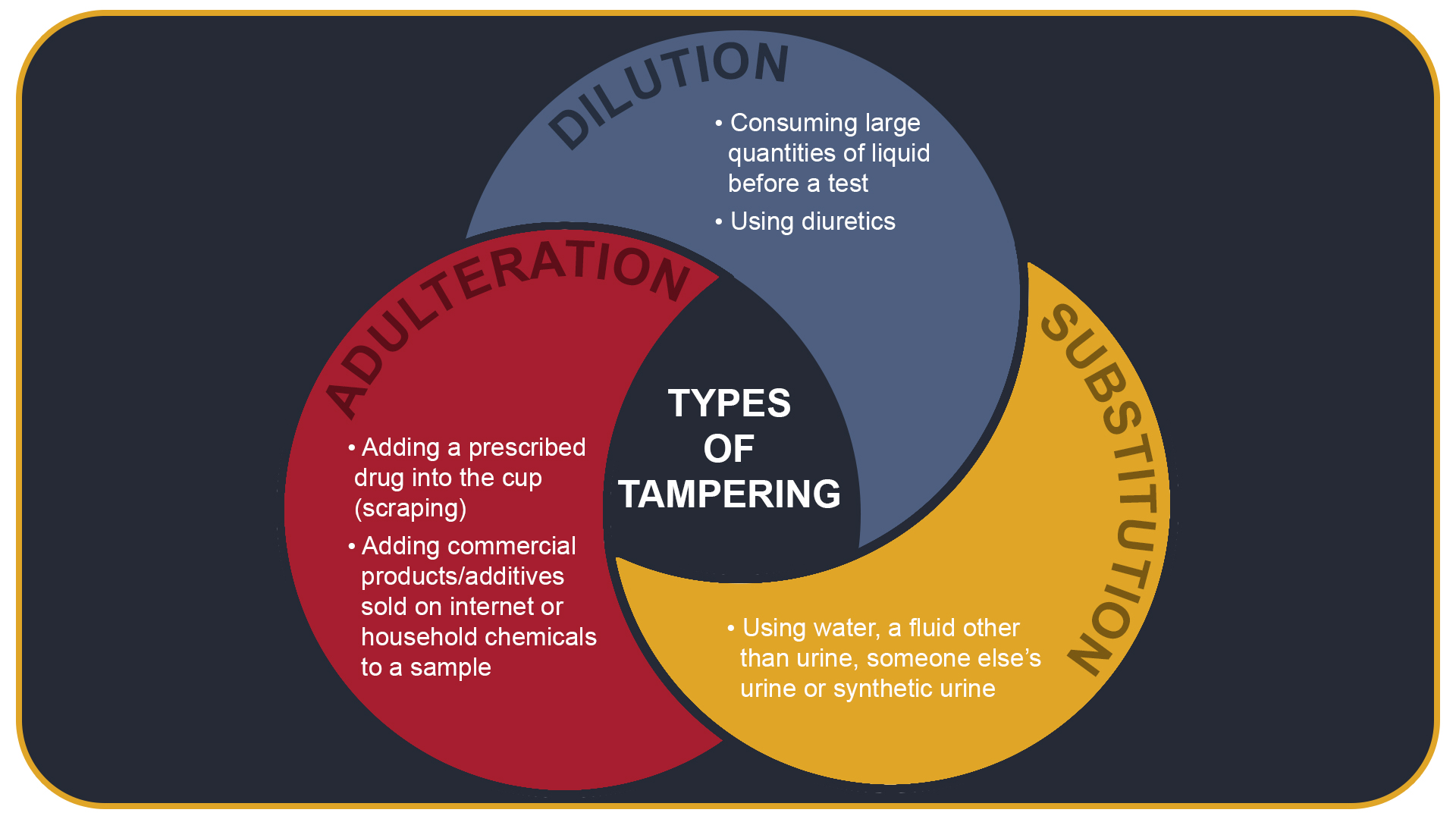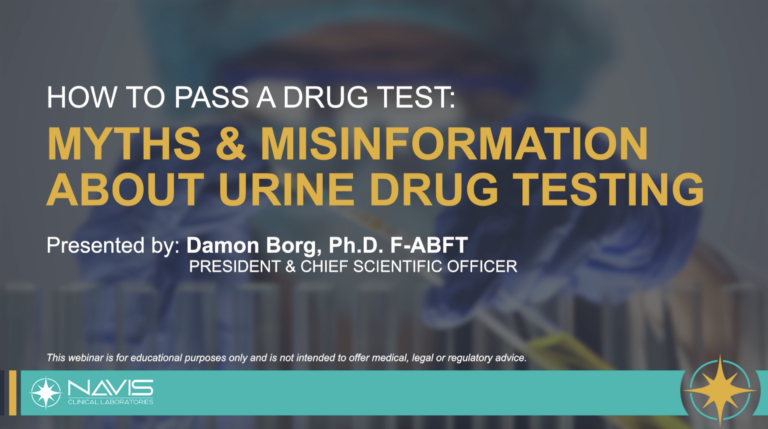
Detecting Urine Drug Test Tampering
You may have seen stories in the news recently about a surge in employment drug test “cheating” – specifically, an increase in substituted or invalid specimens indicating the specimens had been tampered with in an attempt to conceal drug use.
While these reports were specific to employment testing, drug test tampering is possible and quite serious in substance use disorder treatment, chronic pain management and mental health treatment environments as well. Whether in abstinence-based or medication-assisted substance use treatment (MAT), or in mental health treatment, evidence of sample tampering can indicate non-adherence and raise concerns about possible risky or dangerous behavior. Similarly, in pain management, especially opioid therapy, it could be a sign of diversion of prescription medications.
When test results come back invalid or unexpected, a candid conversation with the patient can reveal difficulties they may be experiencing that are negatively impacting their adherence to their treatment plan, while also helping to increase clinician-patient trust and improve adherence and outcomes.
WHAT IS TAMPERING?
“When we talk about ‘tampering’ in urine drug testing, typically we’re talking about dilution, adulteration or substitution,” said Damon Borg, Ph.D., F-ABFT, President and Chief Scientific Officer at Navis Clinical Laboratories. “Patients may do this for different reasons – either to beat a drug test for an illicit or other substance they shouldn’t have taken or to pass a drug test for a prescribed medication they haven’t taken.”
“Patients may do this for different reasons – either to beat a drug test for an illicit or other substance they shouldn’t have taken or to pass a drug test for a prescribed medication they haven’t taken.”
Dr. Borg, Ph.D. F-ABFT, President and Chief Scientific Officer
In employment testing, as recently reported in the news, most tampering is an effort to conceal drug use. In chronic pain management, tampering can be an attempt to test positive for a drug that has been prescribed but not taken, possibly because the patient has diverted the drug, either selling it or giving it away. For MAT, it can be both. Patients may tamper to attempt to hide other drug use or to test positive for their prescribed medications.
Reasons for tampering are not always nefarious, however. A patient may be experiencing side effects or rationing their medication because they are afraid of running out before their next refill. Tampering may be an attempt to cover up non-adherence to avoid an uncomfortable interaction with the provider. Research on measuring adherence has shown that patients often overstate adherence because they fear disappointing their provider.

TOOLS TO IDENTIFY TAMPERING
Most often, there are protocols in place both at the time of collection and in the laboratory to identify tampering. The specimen collector will examine the sample for temperature, color, clarity, and foaminess and reject the sample or ask for a new sample if the original sample is determined invalid.
In the laboratory, there are several methods that can be employed to determine specimen validity.
“Is it a valid sample, and if not, what evidence are we seeing that shows potential tampering?”
Dr. Borg, Ph.D. F-ABFT, President and Chief Scientific Officer
“When specimen validity testing is performed on samples received at the laboratory, we’re looking at factors like pH level, specific gravity, creatinine level, uric acid, and the presence of additives,” said Dr. Borg. “Is it a valid sample, and if not, what evidence are we seeing that shows potential tampering?”
Below are some common methods used in the laboratory for determining specimen validity and detecting possible tampering in urine drug testing.
Creatinine is a chemical waste molecule generated from muscle metabolism and eliminated via the kidneys. It is not affected by diet or normal physical activity and is naturally eliminated in the urine at a relatively stable rate. Therefore, the urine creatinine level can serve as a marker for patient hydration state. Most normal urine samples will have a creatinine value between 20–350 mg/dL. A specimen with a urine creatinine level less than 20 mg/dL is considered dilute. Less than 2% of the population normally produce a urine sample with a creatinine level under 20 mg/dL.
When the urine is dilute, the concentration of drugs in a specimen will be lower. A negative result when the urine is dilute does not assure non-drug use and is considered invalid. Conversely, a positive result on a dilute specimen would indicate the drug concentration in the specimen is high enough to be detected despite being dilute, therefore, it is a valid result.
Urine is comprised of water, salts and waste products filtered from the kidneys, all of which affect the urine pH. While human urine pH can fluctuate throughout the day, the normal range is between 4.5 and 8.9.
The addition of adulterants like bleach, baking soda and drain cleaner, which are more alkaline than urine, would increase the pH of the specimen, indicating tampering.
Specific gravity is a measure of total dissolved solids like salts and other waste products in the urine compared to water. The normal range of human urine specific gravity is between 1.003 and 1.020. Like pH, specific gravity can fluctuate throughout the day, but results outside of this range are usually reported as invalid.
Adulterants have higher specific gravities than urine and would increase the specific gravity of the specimen. Other fluids substituted for urine often have higher or lower specific gravity.
Often, specific gravity is used as a secondary marker to confirm adulteration if the creatinine level indicates a dilute sample.
Uric acid is produced by the metabolic breakdown of purine nucleotides. Purines are natural substances found in foods such as mushrooms and anchovies. They are also produced naturally in the body during the breakdown of cells. An absence of uric acid in a sample would indicate substitution with synthetic urine or another liquid and would be considered invalid.
There are also tests that specifically detect adulterants. General oxidant tests detect a general class of well-known oxidants, including bleach, iodate, chromates, glutaraldehyde, soap, and commercial drug test “detox” or “cleanse” aids. Nitrites and chromates are both generally identified in the oxidant panel but can be more specifically calibrated in additional specific testing.
NOT ALL ABNORMAL RESULTS ARE DUE TO TAMPERING
An invalid test result is not definitive proof of specimen tampering. Sources including SAMHSA and the CDC encourage clinicians to discuss unexpected results with their laboratory or toxicologist, consider other possible causes before assuming that the patient has attempted to subvert the test, and to discuss unexpected results with patients in a nonjudgmental manner. Discussing the unexpected drug test results with patients can sometimes yield a candid explanation of why a particular substance is present or absent and remove the need for confirmatory testing.
Some health, lifestyle and environmental conditions may cause unexpected results. Urinary tract infections or kidney failure can increase urine pH. Common urinary pain relief medications containing phenazopyridine Hcl may cause abnormal specific gravity. Lower pH can occur from diabetic ketoacidosis, starvation or diarrhea. Patients with low body mass or low muscle mass may have low creatinine levels.
Individuals who follow vegetarian or vegan diets and consume low amounts of protein may have urine with higher pH and uric acid. Drinking large quantities of liquids, for perceived health benefits, due to high physical exertion, or being in a hot environment, for example, may produce dilute urine samples.
Navis Clinical Laboratories is proud to partner with clinicians to provide innovative, data-driven solutions that support a person-centered care approach and enhance substance use disorder treatment protocols and harm reduction strategies. Contact us to learn more about specimen validity testing and other solutions to help your practice and your patients.
LEARN MORE
Share this post
Sign up for our Newsletter
By submitting this form, you are consenting to receive marketing emails from Navis Clinical Laboratories. You can unsubscribe at any time by using the SafeUnsubscribe® link found at the bottom of every email.

